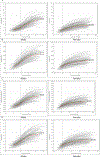An 8-Year Longitudinal Analysis of Physical Activity and Bone Strength From Adolescence to Emerging Adulthood: The Iowa Bone Development Study
- PMID: 31896075
- PMCID: PMC7214197
- DOI: 10.1123/pes.2019-0090
An 8-Year Longitudinal Analysis of Physical Activity and Bone Strength From Adolescence to Emerging Adulthood: The Iowa Bone Development Study
Abstract
Purpose: Most pediatric physical activity and bone health research has focused on the period immediately around puberty; few have addressed bone structural strength outcomes. This study assessed the magnitude and consistency of the longitudinal relationships between device-measured vigorous-intensity physical activity (VPA) and structural bone strength outcomes across adolescence to emerging adulthood.
Methods: Participants with 3 to 5 bone scans between the age of 11 and 19 years were studied (N = 439, 220 females, 1838 records). Dual-energy X-ray absorptiometry scans of the hip (hip structural analysis) and peripheral quantitative computed tomography scans of the tibia were obtained. Outcomes included femoral neck section modulus, femoral neck cross-sectional area, tibial Bone Strength Index, and tibial torsion strength (polar Strength Strain Index). Sex-specific bone mixed growth models were developed using biological age (chronological age - age at peak height velocity) as the time variable, and height, weight, and device-measured VPA as time-varying covariates. Models also included the VPA-biological age interaction.
Results: Individual-centered VPA and the VPA-biological age interaction were significantly, positively associated (P < .05) with Bone Strength Index, polar Strength Strain Index, section modulus, and cross-sectional area in males and females, indicating accumulative effects of VPA throughout maturation and beyond.
Conclusion: Bone remains responsive to the mechanical loading of physical activity throughout adolescence and into emerging adulthood. Attention should be placed on promoting bone-strengthening physical activity after the prepubertal years when adult exercise patterns are likely formed.
Keywords: adolescent; epidemiology; health.
Figures

Similar articles
-
The Relationship Between Greater Prepubertal Adiposity, Subsequent Age of Maturation, and Bone Strength During Adolescence.J Bone Miner Res. 2016 Jul;31(7):1455-65. doi: 10.1002/jbmr.2809. J Bone Miner Res. 2016. PMID: 26861036 Free PMC article. Clinical Trial.
-
Physical Activity Throughout Adolescence and Peak Hip Strength in Young Adults.JAMA Netw Open. 2020 Aug 3;3(8):e2013463. doi: 10.1001/jamanetworkopen.2020.13463. JAMA Netw Open. 2020. PMID: 32804215 Free PMC article.
-
Is vigorous-intensity physical activity required for improving bone mass in adolescence? Findings from a Brazilian birth cohort.Osteoporos Int. 2019 Jun;30(6):1307-1315. doi: 10.1007/s00198-019-04862-6. Epub 2019 Feb 22. Osteoporos Int. 2019. PMID: 30796538 Free PMC article.
-
Physical activity and femoral neck bone strength during childhood: the Iowa Bone Development Study.Bone. 2007 Aug;41(2):216-22. doi: 10.1016/j.bone.2007.05.001. Epub 2007 May 10. Bone. 2007. PMID: 17560839 Free PMC article.
-
Physical activity in the prevention and amelioration of osteoporosis in women : interaction of mechanical, hormonal and dietary factors.Sports Med. 2005;35(9):779-830. doi: 10.2165/00007256-200535090-00004. Sports Med. 2005. PMID: 16138787 Review.
Cited by
-
Associations Between Youth Sport Participation and Bone, Muscle, and Fat in Adulthood: Iowa Bone Development Study.Int J Environ Res Public Health. 2025 Mar 12;22(3):416. doi: 10.3390/ijerph22030416. Int J Environ Res Public Health. 2025. PMID: 40238574 Free PMC article.
-
The Influence of Accelerometer Epoch Length on Associations of Physical Activity Intensity and Volume with Bone Outcomes.J Sports Sci Med. 2023 Mar 1;22(1):117-132. doi: 10.52082/jssm.2023.117. eCollection 2023 Mar. J Sports Sci Med. 2023. PMID: 36876186 Free PMC article.
-
Is device-measured vigorous physical activity associated with health-related outcomes in children and adolescents? A systematic review and meta-analysis.J Sport Health Sci. 2021 May;10(3):296-307. doi: 10.1016/j.jshs.2020.12.001. Epub 2020 Dec 5. J Sport Health Sci. 2021. PMID: 33285309 Free PMC article.
-
Association of objectively measured physical activity and bone health in children and adolescents: a systematic review and narrative synthesis.Osteoporos Int. 2020 Oct;31(10):1865-1894. doi: 10.1007/s00198-020-05485-y. Epub 2020 Jun 16. Osteoporos Int. 2020. PMID: 32542544
-
Effects of exercise on bone mass and bone metabolism in adolescents: a systematic review and meta-analysis.Front Physiol. 2024 Dec 24;15:1512822. doi: 10.3389/fphys.2024.1512822. eCollection 2024. Front Physiol. 2024. PMID: 39777358 Free PMC article.
References
-
- 2018 Physical Activity Guidelines Advisory Committee. 2018 Physical Activity Guidelines Advisory Committee Scientific Report. Washington, DC: US Department of Health and Human Services, 2018.
-
- Baxter-Jones AD, Faulkner RA, Forwood MR, Mirwald RL, Baily DA. Bone mineral accrual from 8 to 30 years of age: an estimation of peak bone mass. J Bone Miner Res. 2011;26(8):1729–1739. - PubMed
-
- Beck BR. Exercise for bone in childhood – hitting the sweet spot. Ped Exerc Sci. 2017;29:440–449. - PubMed
-
- Craigie AM, Lake AA, Kelly SA, Adamson AJ, Mathers JC. Tracking of obesity-related behaviours from childhood to adulthood: A systematic review. Maturitas. 2011;70:266–284. - PubMed

